Abstract
Transpleural lavage of lungs from uninfected C3H mice yielded an average of 300,000 leukocytes per mouse. This number increased eightfold within 6 days after intranasal inoculation with virulent influenza A/Hong Kong/68 (H3N2) virus. Macrophages and lymphocytes in approximately equal numbers comprised 90% or more of the leukocytes both before and during infection. B, T, and null lymphocytes comprised, respectively, 9, 21, and 18% of the leukocytes before infection and 7, 26, and 5% by day 6. In absolute numbers, macrophages and T lymphocytes provided the major increments during infection. Cytotoxic activity of mononuclear cells from lung lavages was compared in a chromium release assay using syngeneic L929 target cells with the activity of mediastinal lymph nodes, spleens, and peripheral blood of uninfected and infected C3H mice. Nonspecific cytotoxicity for target cells infected with H3hkNeq1 or B/Lee influenza virus was found with mononuclear cells from uninfected mice. This activity tended to be highest with lavage leukocytes and was associated with adherent cells, presumably macrophages. Increased virus-specific cytotoxicity was detected with lavage cells by day 6 and persisted through day 9, the period of maximal pneumonia. Similar cytotoxic activity also appeared in cells from the nodes and spleen at this same time but was not detected in peripheral blood cells. The virus-specific cytotoxicity of lavage cells was due largely to a nonadherent cell possessing Fc receptors and theta antigen but lacking C3 receptors; these properties are compatible with actively cytotoxic T lymphocytes. The cytological characteristics of the infiltrating leukocytes and the cytotoxicity data suggest that the local T cell response to influenza virus infection in the lung is a major contributor to the pneumonia observed in this mouse model.
Full text
PDF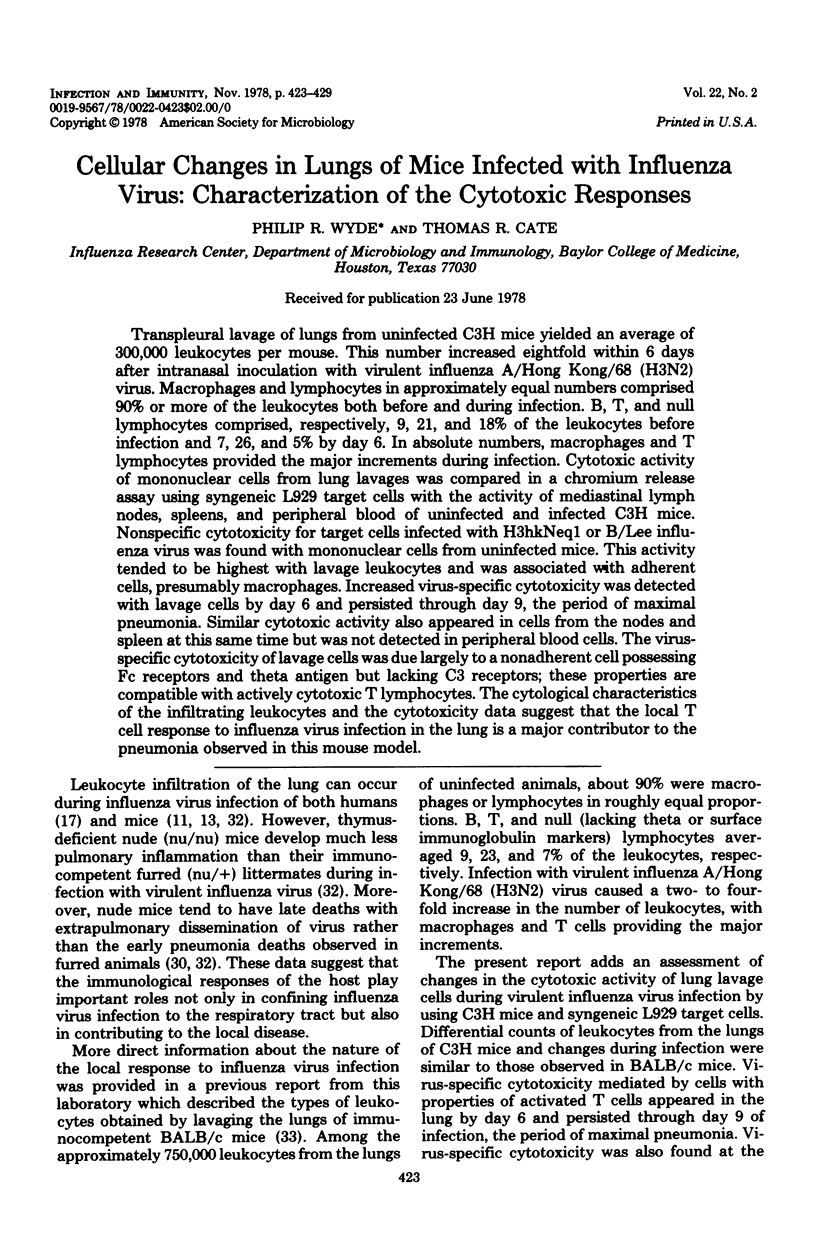
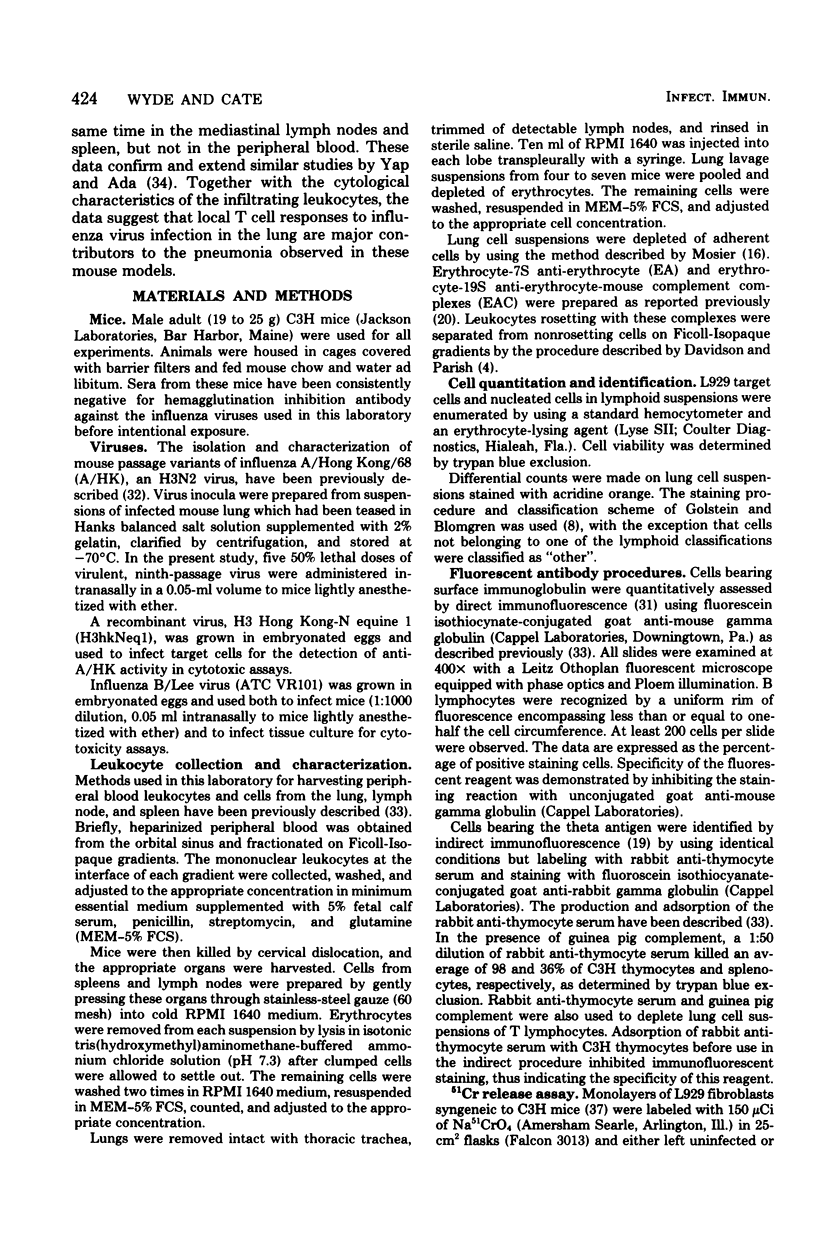
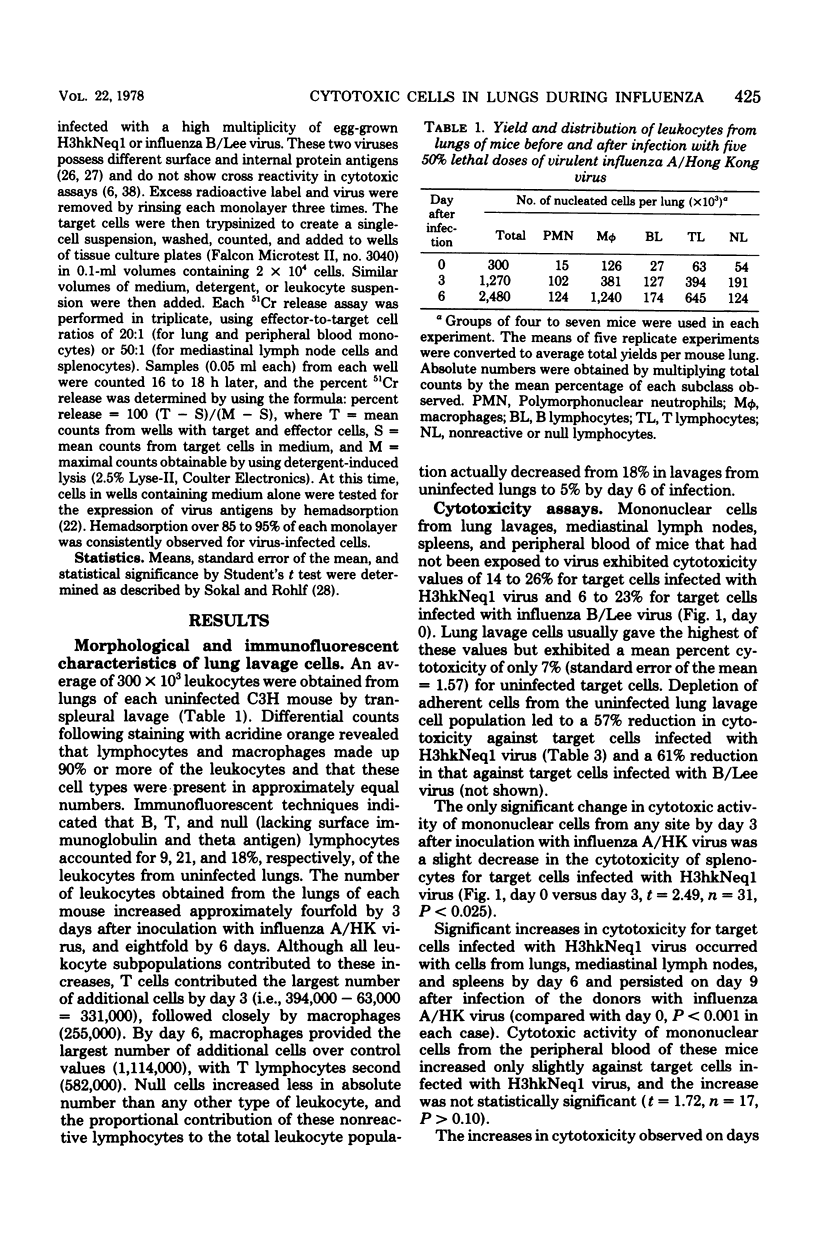
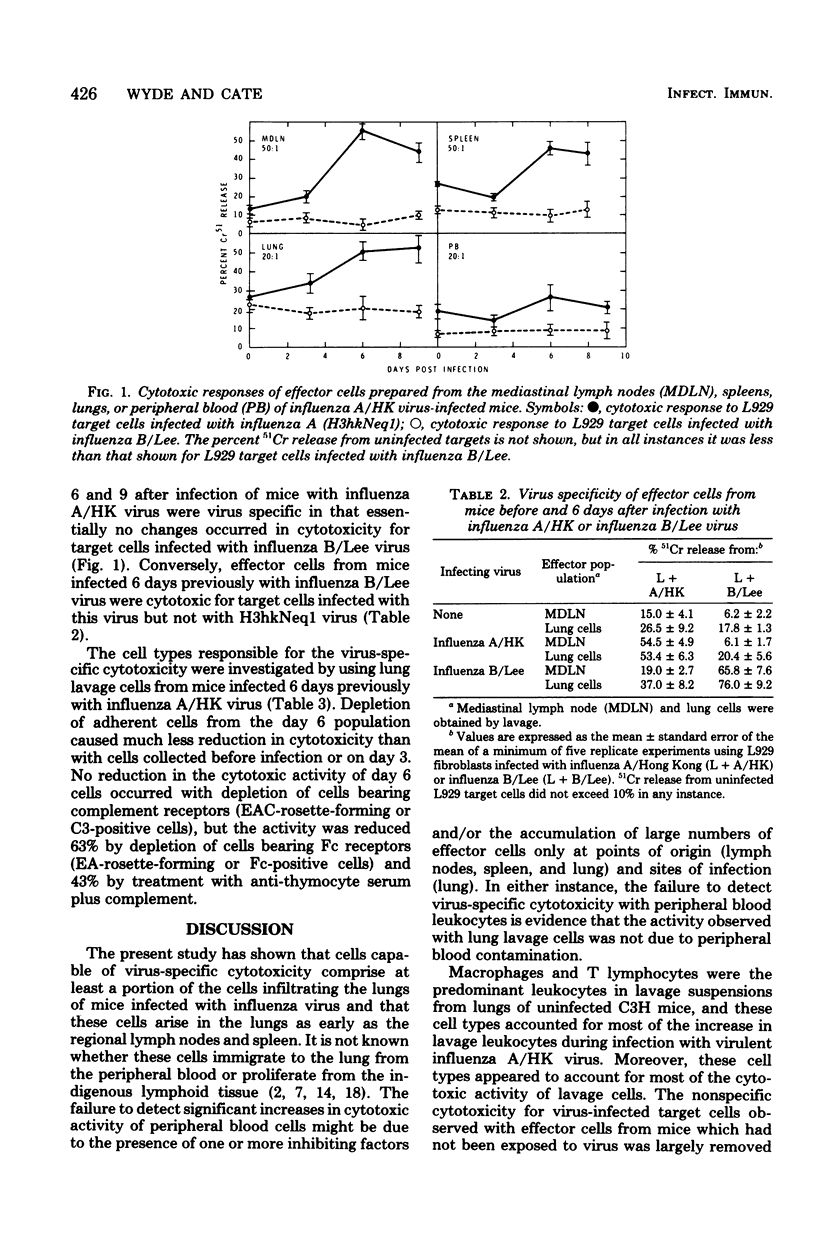
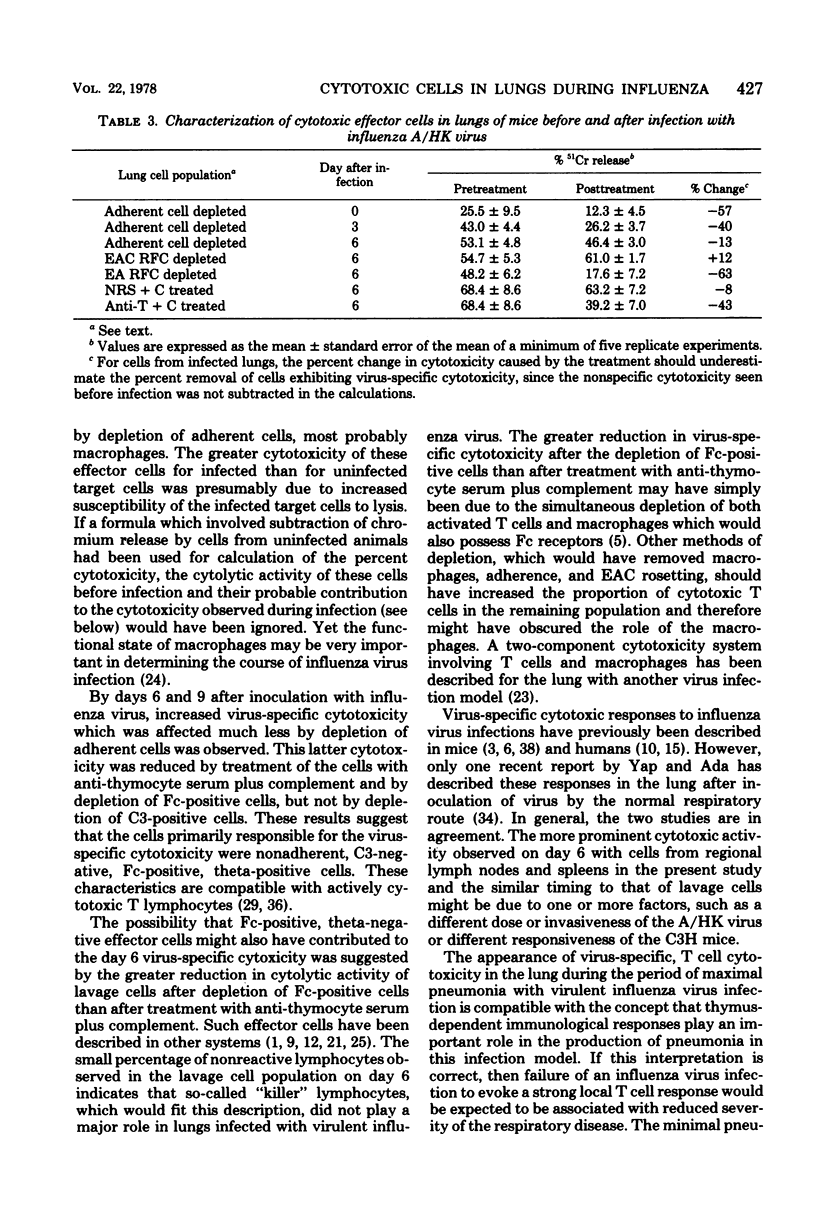
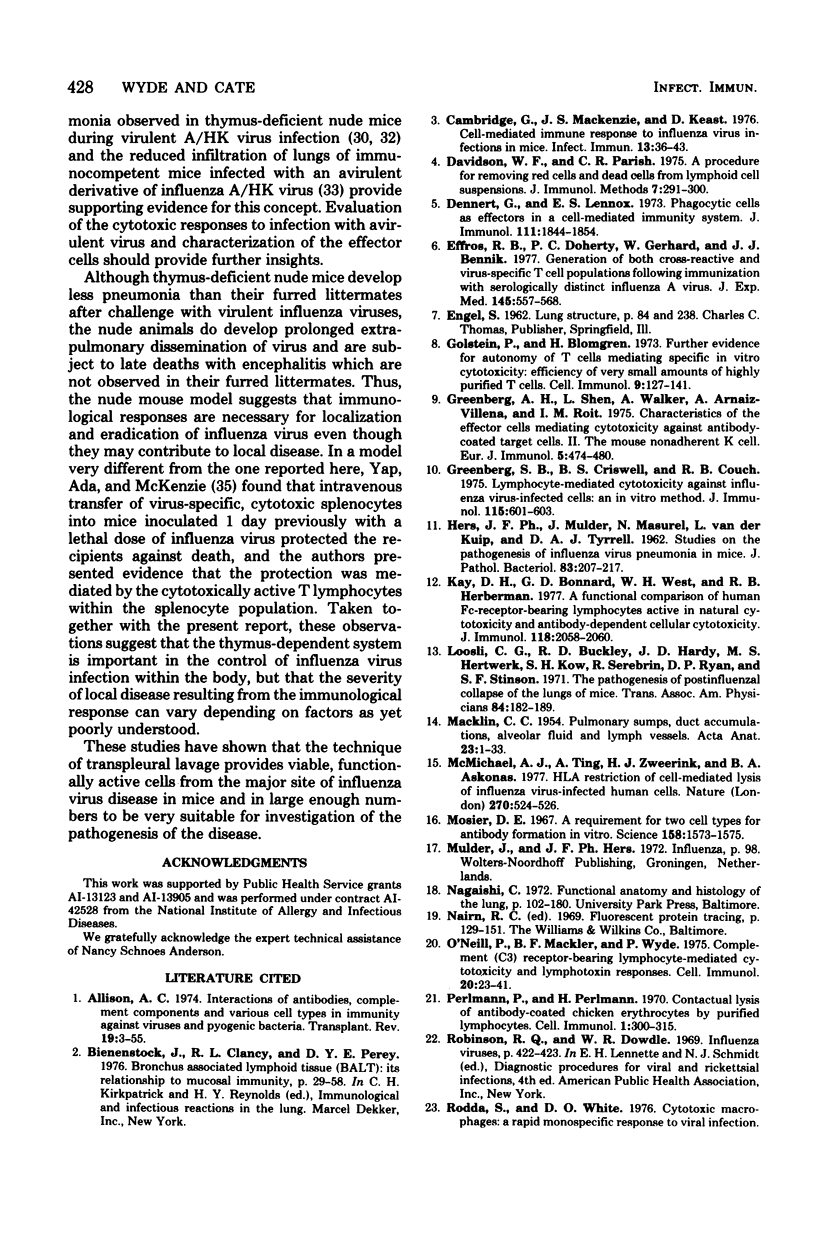
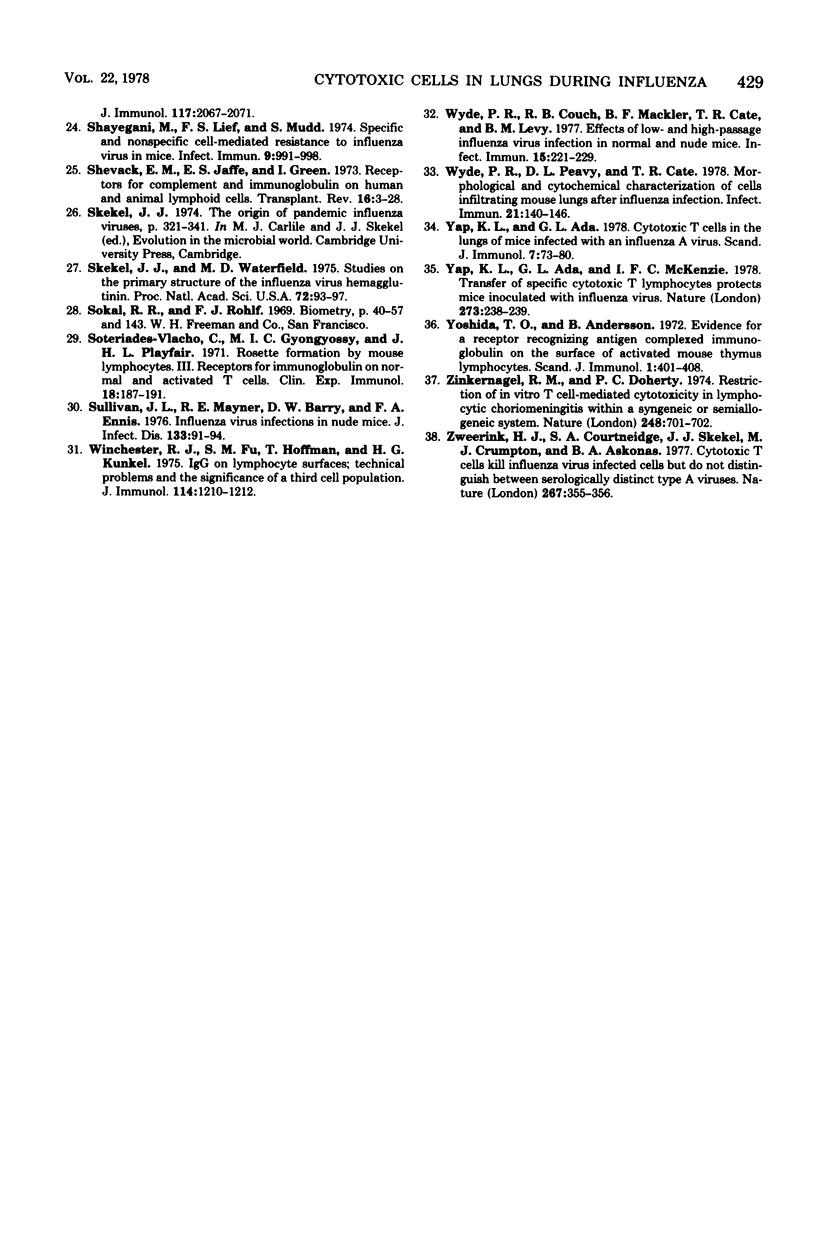
Selected References
These references are in PubMed. This may not be the complete list of references from this article.
- Allison A. C. Interactions of antibodies, complement components and various cell types in immunity against viruses and pyogenic bacteria. Transplant Rev. 1974;19(0):3–55. doi: 10.1111/j.1600-065x.1974.tb00127.x. [DOI] [PubMed] [Google Scholar]
- Cambridge G., Mackenzie J. S., Keast D. Cell-mediated immune response to influenza virus infections in mice. Infect Immun. 1976 Jan;13(1):36–43. doi: 10.1128/iai.13.1.36-43.1976. [DOI] [PMC free article] [PubMed] [Google Scholar]
- Davidson W. F., Parish C. R. A procedure for removing red cells and dead cells from lymphoid cell suspensions. J Immunol Methods. 1975 Jun;7(2-3):291–300. doi: 10.1016/0022-1759(75)90026-5. [DOI] [PubMed] [Google Scholar]
- Dennert G., Lennox E. S. Phagocytic cells as effectors in a cell-mediated immunity system. J Immunol. 1973 Dec;111(6):1844–1854. [PubMed] [Google Scholar]
- Effros R. B., Doherty P. C., Gerhard W., Bennink J. Generation of both cross-reactive and virus-specific T-cell populations after immunization with serologically distinct influenza A viruses. J Exp Med. 1977 Mar 1;145(3):557–568. doi: 10.1084/jem.145.3.557. [DOI] [PMC free article] [PubMed] [Google Scholar]
- Golstein P., Blomgren H. Further evidence for autonomy of T cells mediating specific in vitro cytotoxicity: efficiency of very small amounts of highly purified T cells. Cell Immunol. 1973 Oct;9(1):127–141. doi: 10.1016/0008-8749(73)90174-3. [DOI] [PubMed] [Google Scholar]
- Greenberg A. H., Shen L., Walker L., Arnaiz-Villena A., Roitt I. M. Characteristics of the effector cells mediating cytotoxicity against antibody-coated target cells. II. The mouse nonadherent K cell. Eur J Immunol. 1976 Jul;5(7):474–480. doi: 10.1002/eji.1830050709. [DOI] [PubMed] [Google Scholar]
- Greenberg S. B., Criswell B. S., Couch R. B. Lymohocyte-mediated cytotoxicity against influenza virus-infected cells: an in vitro method. J Immunol. 1975 Aug;115(2):601–603. [PubMed] [Google Scholar]
- HERS J. F., MUDLER J., MASUREL N., vd KUIP L., TYRRELL D. A. Studies on the pathogenesis of influenza virus pneumonia in mice. J Pathol Bacteriol. 1962 Jan;83:207–217. [PubMed] [Google Scholar]
- Kay H. D., Bonnard G. D., West W. H., Herberman R. B. A functional comparison of human Fc-receptor-bearing lymphocytes active in natural cytotoxicity and antibody-dependent cellular cytotoxicity. J Immunol. 1977 Jun;118(6):2058–2066. [PubMed] [Google Scholar]
- Loosli C. G., Buckley R. D., Hardy J. D., Hertweck M. S., Kow S. Y., Serebrin R., Ryan D. P., Stinson S. F. The pathogenesis of postinfluenzal collapse of the lungs of mice. Trans Assoc Am Physicians. 1971;84:182–189. [PubMed] [Google Scholar]
- MACKLIN C. C. Pulmonary sumps, dust accumulations, alveolar fluid and lymph vessels. Acta Anat (Basel) 1955;23(1):1–33. doi: 10.1159/000140979. [DOI] [PubMed] [Google Scholar]
- McMichael A. J., Ting A., Zweerink H. J., Askonas B. A. HLA restriction of cell-mediated lysis of influenza virus-infected human cells. Nature. 1977 Dec 8;270(5637):524–526. doi: 10.1038/270524a0. [DOI] [PubMed] [Google Scholar]
- Mosier D. E. A requirement for two cell types for antibody formation in vitro. Science. 1967 Dec 22;158(3808):1573–1575. doi: 10.1126/science.158.3808.1573. [DOI] [PubMed] [Google Scholar]
- O'Neill P., Mackler B. F., Wyde P. Complement (C3) receptor-bearing lymphocyte-mediated cytotoxicity and lymphotoxin responses. Cell Immunol. 1975 Nov;20(1):33–41. doi: 10.1016/0008-8749(75)90081-7. [DOI] [PubMed] [Google Scholar]
- Perlmann P., Perlmann H. Contactual lysis of antibody-coated chicken erythrocytes by purified lymphocytes. Cell Immunol. 1970 Sep;1(3):300–315. doi: 10.1016/0008-8749(70)90051-1. [DOI] [PubMed] [Google Scholar]
- Rodda S. J., White D. O. Cytotoxic macrophages: a rapid nonspecific response to viral infection. J Immunol. 1976 Dec;117(6):2067–2072. [PubMed] [Google Scholar]
- Shayegani M., Lief F. S., Mudd S. Specific and nonspecific cell-mediated resistance to influenza virus in mice. Infect Immun. 1974 Jun;9(6):991–998. doi: 10.1128/iai.9.6.991-998.1974. [DOI] [PMC free article] [PubMed] [Google Scholar]
- Shevach E. M., Jaffe E. S., Green I. Receptors for complement and immunoglobulin on human and animal lymphoid cells. Transplant Rev. 1973;16:3–28. doi: 10.1111/j.1600-065x.1973.tb00115.x. [DOI] [PubMed] [Google Scholar]
- Skehel J. J., Waterfield M. D. Studies on the primary structure of the influenza virus hemagglutinin. Proc Natl Acad Sci U S A. 1975 Jan;72(1):93–97. doi: 10.1073/pnas.72.1.93. [DOI] [PMC free article] [PubMed] [Google Scholar]
- Soteriades-Vlachos C., Gyöngyössy M. I., Playfair J. H. Rosette formation by mouse lymphocytes. III. Receptors for immunoglobulin on normal and activated T cells. Clin Exp Immunol. 1974 Oct;18(2):187–192. [PMC free article] [PubMed] [Google Scholar]
- Sullivan J. L., Mayner R. E., Barry D. W., Ennis F. A. Influenza virus infection in nude mice. J Infect Dis. 1976 Jan;133(1):91–94. doi: 10.1093/infdis/133.1.91. [DOI] [PubMed] [Google Scholar]
- Winchester R. J., Fu S. M., Hoffman T., Kunkel H. G. IgG on lymphocyte surfaces; technical problems and the significance of a third cell population. J Immunol. 1975 Apr;114(4):1210–1212. [PubMed] [Google Scholar]
- Wyde P. R., Couch R. B., Mackler B. F., Cate T. R., Levy B. M. Effects of low- and high-passage influenza virus infection in normal and nude mice. Infect Immun. 1977 Jan;15(1):221–229. doi: 10.1128/iai.15.1.221-229.1977. [DOI] [PMC free article] [PubMed] [Google Scholar]
- Wyde P. R., Peavy D. L., Cate T. R. Morphological and cytochemical characterization of cells infiltrating mouse lungs after influenza infection. Infect Immun. 1978 Jul;21(1):140–146. doi: 10.1128/iai.21.1.140-146.1978. [DOI] [PMC free article] [PubMed] [Google Scholar]
- Yap K. L., Ada G. L. Cytotoxic T cells in the lungs of mice infected with an influenza A virus. Scand J Immunol. 1978;7(1):73–80. doi: 10.1111/j.1365-3083.1978.tb00428.x. [DOI] [PubMed] [Google Scholar]
- Yap K. L., Ada G. L., McKenzie I. F. Transfer of specific cytotoxic T lymphocytes protects mice inoculated with influenza virus. Nature. 1978 May 18;273(5659):238–239. doi: 10.1038/273238a0. [DOI] [PubMed] [Google Scholar]
- Yoshida T. O., Andersson B. Evidence for a receptor recognizing antigen complexed immunoglobulin on the surface of activated mouse thymus lymphocytes. Scand J Immunol. 1972;1(4):401–408. doi: 10.1111/j.1365-3083.1972.tb03306.x. [DOI] [PubMed] [Google Scholar]
- Zinkernagel R. M., Doherty P. C. Restriction of in vitro T cell-mediated cytotoxicity in lymphocytic choriomeningitis within a syngeneic or semiallogeneic system. Nature. 1974 Apr 19;248(5450):701–702. doi: 10.1038/248701a0. [DOI] [PubMed] [Google Scholar]
- Zweerink H. J., Courtneidge S. A., Skehel J. J., Crumpton M. J., Askonas B. A. Cytotoxic T cells kill influenza virus infected cells but do not distinguish between serologically distinct type A viruses. Nature. 1977 May 26;267(5609):354–356. doi: 10.1038/267354a0. [DOI] [PubMed] [Google Scholar]


